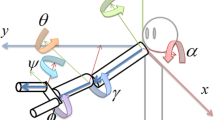Abstract
This paper describes an adaptive neural control system for governing the movements of a robotic wheelchair. It presents a new model of recurrent neural network based on a RBF architecture and combining in its architecture local recurrence and synaptic connections with FIR filters. This model is used in two different control architectures to command the movements of a robotic wheelchair. The training equations and the stability conditions of the control system are obtained. Practical tests show that the results achieved using the proposed method are better than those obtained using PID controllers or other recurrent neural networks models
Similar content being viewed by others
References
Acosta, L., Méndez, J.A., Torres, S., Moreno, L., and Marichal,G.N. 1999. On the design and implementation of a neuromor-phicselft-tuning controller. Neural Processing Letters, 9(3):229–242.
Boquete, L., Barea, R., García, R., Mazo, M., and Espinosa, F. 1999a.Identification and control of a wheelchair using recurrent neu-ralnetworks. Engineering Applications of Artificial Intelligence,12(4):443–452.
Boquete, L., García, R., Barea, R., and Mazo, M. 1999b. Neuralcontrol of the movements of a wheelchair. Journal of Intelligentand Robotic Systems, 25(3):213–226.
Boquete, L., Martín, P., Mazo, M., García, R., Barea, R., Rodríguez,F.J., and Fernández, I. 2002. Hardware implementation of anew neurocontrol wheelchair-guidance system. Neurocomputing,47(1):145–160.
Brown, K.E., Iñigo, R.M., and Johnson, B.W. 1990. Design, implementation and testing of an adaptable optimal controller for anelectric wheelchair. IEEE Transactions on Industrial Applications,26(6):1144–1157.
Campolucci, P., Uncini, A., Piazza, F., and Rao, B.D. 1999. On-linelearning algorithms for locally recurrent neural networks. IEEETransactions on Neural Networks, 10(2):253–271.
Chen, C.-L., Chen, W.-C., and Chang, F.-Y. 1993. Hybrid learn-ingalgorithm for Gaussian potential function networks. IEEProceedingsd, 140(6):442–448.
Ciocoiu, I.B. 1996. Radial base function networks with FIR/IIRsynapses. Neural Processing Letters, 3:7–22.
Cooper, R.A. 1995. Intelligent control of power wheelchairs. IEEEEngineering in Medicine and Biology, 4:423–431.
Cooper, R.A., Corfman, T.A., Fitzgerald, S.G., Boninger, M.L., Spaeth, D.M., Ammer, W., and Arva, J. 2002. Perfomance assessment of a push rim-activated power-assisted wheelchair controlsystem. IEEE Transactions on Control Systems Technology,10(1):121–126.
Elman, J.L. 1990. Finding structure in time. Cognitive Sci., 14:179–211.
Espinosa, F., L´ opez, E., Mateos, R., Mazo, M., and García, R. 2001.Advanced and intelligent control techniques applied to the drivecontrol and path tracking systems on a robotic wheelchair. Autonomous Robots, 11:137–148.
Figueiredo, R.J.P. 1998. Optimal interpolating and smoothing functional artificial neural networks (FANN'S) based on a generalizedfock space framework. Circuits Syst. Signal Processing, 17:271–287.
Krovi, V. and Kumar, V. 1999. Modeling and control of a hybrid locomotion system. ASMEJournal of Mechanical Design, 121(3):448–455.
Ku, C.C. and Lee, K.Y. 1995. Diagonal recurrent neural networks fordynamic systems control. IEEE Transactions on Neural Networks,6(1):144–156.
Kuc, T.-Y., Baek, S.-M., and Park, K. 2001. Adaptive learning controller for autonomous mobile robots. IEE Proc.Control TheoryApply, 148(1):49-54.
Maeda, Y. and Figueiredo, R. J. P. 1997. Learning rules for neuro-controllervia simultaneous perturbation. IEEE Transactions onNeural Networks, 8(5):1119–1130.
Mazo, M. et al. 2001. An integral system for assisted mobility. IEEERobotics & Automation Magazine, 7(1):46–56.
Mulgrew, B. 1996. Appliying radial basis functions. IEEE SignalProcessing Magazine, 13(2):50–65.
Narendra, K.S. and Parthasarathy, K. 1990. Identification and controlof dynamical systems using neural networks. IEEE Transactionson Neural Networks, 1(1):4–27.
Oriolo, G., de Luca, A., and Vendittelli, M. 2002. WMR controlvia dynamic feedback linearization: Design, implementation andexperimental validation. IEEE Transactions on Control SystemsTechnology, 10(6):835–852.
Sastry, P.S., Santharam, G., and Unnikrishnan, K.P. 1994. Memoryneuron networks for identification and control of dynamicalsystems. IEEE Transactions on Neural Networks, 5(2):306–319.
Tsoi, A.C. and Back, A.D. 1994. Locally recurrent globally feed forward networks: A critical review of architectures. IEEE Transactions on Neural Networks, 5(2):229–239.
Wellman, P., Krovi, V., Kumar, V., and Harwin, W. 1995. Designof a wheelchair with legs for people with motor disabilities.IEEE Transactions on Rehabilitation Engineering, 3(4):343–349.
Yu, H., Spenko, M., and Dubowsky, S. 2003. An adaptive sharedcontrol system for an intelligent mobility aid for the elderly. Autonomous Robots, 15:53–66.
Zhang, Y., Sen, P., and Hearn, G.E. 1995. An online trained adaptiveneural controller. IEEE Control Systems, 15(5):67–75.
Author information
Authors and Affiliations
Rights and permissions
About this article
Cite this article
Boquete, L., Barea, R., García, R. et al. Control of a Robotic Wheelchair Using Recurrent Networks. Autonomous Robots 18, 5–20 (2005). https://doi.org/10.1023/B:AURO.0000047285.40228.eb
Issue Date:
DOI: https://doi.org/10.1023/B:AURO.0000047285.40228.eb




